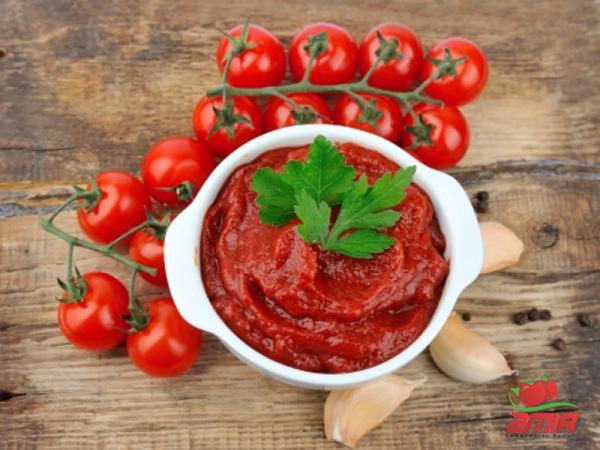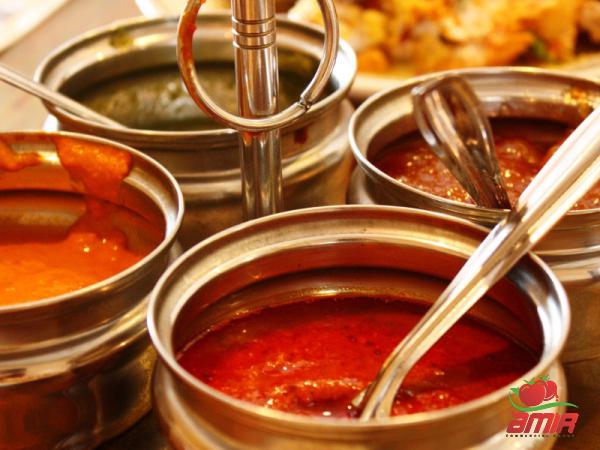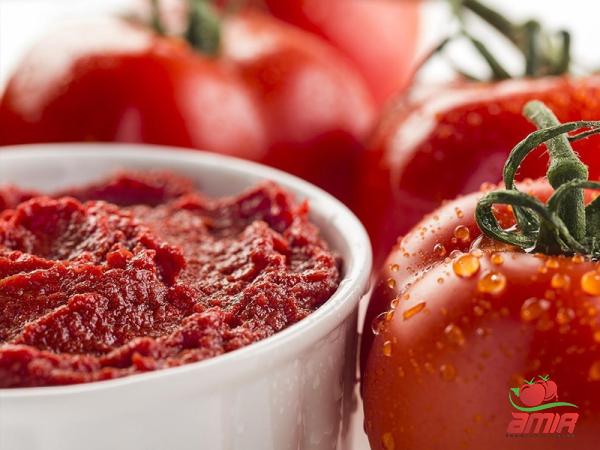Enhancing the Flavor and Texture of Sauces with Tomato Paste Introduction: Tomato paste is a versatile ingredient that serves as an essential base for numerous savory dishes, particularly in sauces. Its concentrated flavor and thick texture make it an excellent addition to enhance the taste, color, and consistency of various recipes. This article will explore the benefits of using tomato paste in sauce-making and provide tips on incorporating it effectively. 1. Tomato Paste: A Culinary Powerhouse Tomato paste is made by cooking down tomatoes and reducing them to a thick, concentrated paste. This process eliminates excess moisture while intensifying the natural flavor. As a result, tomato paste possesses a rich, tangy, and slightly sweet taste that enhances the overall profile of sauces. 2. Flavor Enhancer: Adding tomato paste to sauces brings a depth of flavor and complexity. Its concentrated form allows for a more intense tomato taste that blends well with other ingredients. The umami-rich properties of tomato paste impart a savory and satisfying flavor, enhancing the overall taste of the sauce. It works particularly well in tomato-based sauces such as marinara, Bolognese, and arrabbiata. 3. Color Booster: Tomato paste works wonders in adding vibrant reddish hues to sauces, making them visually appealing. Its deep red color infuses the sauce and helps create an appetizing presentation. Whether you are making a hearty pasta sauce, pizza sauce, or even a curry base, tomato paste provides a visually enticing appearance. 4. Thickening Agent: One of the unique attributes of tomato paste is its ability to thicken sauces. Its concentrated nature helps sauces achieve the desired consistency while avoiding excess moisture. Tomato paste is especially useful when making creamy or rich flavored sauces like Alfredo or vodka sauce, as it adds texture without relying on excessive amounts of cream or cheese. 5. Balancing Sweetness and Acidity: Tomato paste is a valuable ingredient in balancing the acidity and sweetness in sauces. Its inherent sweetness counteracts the acidic taste of tomatoes, creating a harmonious balance. This balance is of particular importance when crafting sauces with ingredients like vinegar, lemon juice, or wine, as tomato paste provides a complementary flavor that prevents the sauce from becoming overly acidic.

tomato paste
 6. Tips for Using Tomato Paste: a) Sautéing for Maximum Flavor: Before incorporating tomato paste into your sauce, it is advisable to sauté it in oil or butter. This technique helps to caramelize the tomato paste, enhancing its natural sweetness and deepening the flavor profile. b) Blooming the Aroma: Toasting tomato paste for a short period in the pan can also help unlock its deep flavors and intensify its aroma. This process is especially beneficial in recipes that call for spices or herbs, as it allows the tomato paste to absorb their flavors more effectively. c) Dilution: Tomato paste can be quite potent, so it is essential to dilute it with other liquids like broth, water, or wine before incorporating it into your sauce. Gradually stirring in the liquid will ensure even distribution and prevent any lumps from forming. d) Incorporating Tomato Paste: Add tomato paste early in the cooking process to allow its flavors to meld with other ingredients. This extended cook time helps ensure a smooth integration of flavors throughout the sauce. e) Storage: Tomato paste is often sold in small cans or tubes, leaving behind excess amounts. To avoid waste, transfer any remaining paste to an airtight container and store it in the refrigerator. Alternatively, portion the paste into smaller amounts and freeze them for future use. Conclusion: Tomato paste is a culinary powerhouse that serves as a game-changer in sauce-making. It not only enhances the flavor and texture but also adds vibrant color and balances sweetness and acidity. By utilizing tomato paste effectively in various sauce recipes, you can elevate your dishes to new heights, ensuring a memorable dining experience for yourself and those you serve.I. The Importance of Flavor Enhancement in Sauces When it comes to creating delicious and memorable sauces, flavor enhancement is key. Adding tomato paste to your sauces not only intensifies the taste but also adds a unique depth of flavor. The concentrated nature of tomato paste allows it to blend seamlessly with other ingredients, amplifying their impact on the overall taste of the sauce. This enhanced flavor profile can elevate even the simplest of dishes to gourmet status, making it a valuable addition to any chef’s pantry. II. Enhancing Visual Appeal with Vibrant Colors In addition to flavor enhancement, tomato paste plays a crucial role in improving the visual appeal of sauces. Its deep red color infuses sauces, making them visually enticing and appetizing. This is particularly important in dishes where appearance matters, such as pasta sauces, curries, or even tomato-based soups. The vibrant hues imparted by tomato paste create a visually pleasing experience, enhancing the overall presentation of the dish.
6. Tips for Using Tomato Paste: a) Sautéing for Maximum Flavor: Before incorporating tomato paste into your sauce, it is advisable to sauté it in oil or butter. This technique helps to caramelize the tomato paste, enhancing its natural sweetness and deepening the flavor profile. b) Blooming the Aroma: Toasting tomato paste for a short period in the pan can also help unlock its deep flavors and intensify its aroma. This process is especially beneficial in recipes that call for spices or herbs, as it allows the tomato paste to absorb their flavors more effectively. c) Dilution: Tomato paste can be quite potent, so it is essential to dilute it with other liquids like broth, water, or wine before incorporating it into your sauce. Gradually stirring in the liquid will ensure even distribution and prevent any lumps from forming. d) Incorporating Tomato Paste: Add tomato paste early in the cooking process to allow its flavors to meld with other ingredients. This extended cook time helps ensure a smooth integration of flavors throughout the sauce. e) Storage: Tomato paste is often sold in small cans or tubes, leaving behind excess amounts. To avoid waste, transfer any remaining paste to an airtight container and store it in the refrigerator. Alternatively, portion the paste into smaller amounts and freeze them for future use. Conclusion: Tomato paste is a culinary powerhouse that serves as a game-changer in sauce-making. It not only enhances the flavor and texture but also adds vibrant color and balances sweetness and acidity. By utilizing tomato paste effectively in various sauce recipes, you can elevate your dishes to new heights, ensuring a memorable dining experience for yourself and those you serve.I. The Importance of Flavor Enhancement in Sauces When it comes to creating delicious and memorable sauces, flavor enhancement is key. Adding tomato paste to your sauces not only intensifies the taste but also adds a unique depth of flavor. The concentrated nature of tomato paste allows it to blend seamlessly with other ingredients, amplifying their impact on the overall taste of the sauce. This enhanced flavor profile can elevate even the simplest of dishes to gourmet status, making it a valuable addition to any chef’s pantry. II. Enhancing Visual Appeal with Vibrant Colors In addition to flavor enhancement, tomato paste plays a crucial role in improving the visual appeal of sauces. Its deep red color infuses sauces, making them visually enticing and appetizing. This is particularly important in dishes where appearance matters, such as pasta sauces, curries, or even tomato-based soups. The vibrant hues imparted by tomato paste create a visually pleasing experience, enhancing the overall presentation of the dish.
Specifications of tomato paste
 III. Achieving the Desired Consistency with Thickening Properties Creating the perfect texture and consistency in sauces is a delicate balance. Tomato paste serves as an excellent thickening agent, allowing sauces to achieve the desired texture without excessive moisture. Its concentrated form minimizes the risk of watery sauces while delivering a velvety smoothness. Whether you’re making a hearty ragù or a creamy tomato bisque, tomato paste can help you achieve the perfect consistency. IV. Balancing Acidity and Sweetness for Harmonious Flavors The balance between acidity and sweetness is crucial in creating well-rounded sauces. Tomato paste plays a vital role in achieving this balance, especially when dealing with a naturally acidic ingredient like tomatoes. The inherent sweetness of tomato paste counteracts the acidity, resulting in a harmonious flavor profile that is neither too sour nor overly sweet. This balance is crucial in creating sauces with complex flavor layers that leave a lasting impression on the palate. V. Versatility in Sauce-Making Tomato paste is incredibly versatile and can be incorporated into a wide range of sauce recipes. From classic tomato-based sauces like marinara and puttanesca to creamy favorites like vodka sauce or even barbecue sauces, tomato paste adds an extra layer of flavor and texture to elevate your culinary creations. Its unique attributes make it a staple ingredient for both home cooks and professional chefs looking to enhance their sauce repertoire. VI. Maximizing the Shelf Life Another advantage of using tomato paste in sauce-making is its ability to prolong the shelf life of the finished product. The natural acidity of tomatoes, combined with the cooking process that concentrates the flavors, helps prevent spoilage and bacterial growth. This enables sauces made with tomato paste to have a longer shelf life compared to sauces without it. Proper storage in airtight containers or freezing in portioned quantities ensures that you can enjoy your delicious homemade sauces for extended periods. VII. Cost-Effective Solution for Bulk Sauce Production For businesses involved in mass production or large-scale catering, tomato paste offers a cost-effective solution. Its concentrated nature allows for the creation of a significant amount of sauce using a relatively small quantity of tomato paste. This can help lower production costs while maintaining consistent quality and flavor across a large volume of sauces. The versatility of tomato paste also allows for variations in recipes, catering to different flavor preferences and dietary requirements.
III. Achieving the Desired Consistency with Thickening Properties Creating the perfect texture and consistency in sauces is a delicate balance. Tomato paste serves as an excellent thickening agent, allowing sauces to achieve the desired texture without excessive moisture. Its concentrated form minimizes the risk of watery sauces while delivering a velvety smoothness. Whether you’re making a hearty ragù or a creamy tomato bisque, tomato paste can help you achieve the perfect consistency. IV. Balancing Acidity and Sweetness for Harmonious Flavors The balance between acidity and sweetness is crucial in creating well-rounded sauces. Tomato paste plays a vital role in achieving this balance, especially when dealing with a naturally acidic ingredient like tomatoes. The inherent sweetness of tomato paste counteracts the acidity, resulting in a harmonious flavor profile that is neither too sour nor overly sweet. This balance is crucial in creating sauces with complex flavor layers that leave a lasting impression on the palate. V. Versatility in Sauce-Making Tomato paste is incredibly versatile and can be incorporated into a wide range of sauce recipes. From classic tomato-based sauces like marinara and puttanesca to creamy favorites like vodka sauce or even barbecue sauces, tomato paste adds an extra layer of flavor and texture to elevate your culinary creations. Its unique attributes make it a staple ingredient for both home cooks and professional chefs looking to enhance their sauce repertoire. VI. Maximizing the Shelf Life Another advantage of using tomato paste in sauce-making is its ability to prolong the shelf life of the finished product. The natural acidity of tomatoes, combined with the cooking process that concentrates the flavors, helps prevent spoilage and bacterial growth. This enables sauces made with tomato paste to have a longer shelf life compared to sauces without it. Proper storage in airtight containers or freezing in portioned quantities ensures that you can enjoy your delicious homemade sauces for extended periods. VII. Cost-Effective Solution for Bulk Sauce Production For businesses involved in mass production or large-scale catering, tomato paste offers a cost-effective solution. Its concentrated nature allows for the creation of a significant amount of sauce using a relatively small quantity of tomato paste. This can help lower production costs while maintaining consistent quality and flavor across a large volume of sauces. The versatility of tomato paste also allows for variations in recipes, catering to different flavor preferences and dietary requirements.
buy tomato paste
 VIII. Enhancing the Menu’s Appeal Including sauces made with tomato paste on your menu can significantly enhance its appeal. Whether you run a restaurant, a food truck, or a catering business, offering a variety of flavorful and visually appealing sauces can attract more customers and keep them coming back for more. A well-thought-out sauce selection can add value to your menu by complementing and elevating other dishes, turning ordinary meals into extraordinary culinary experiences. IX. Meeting Dietary Preferences and Requirements With the increasing demand for dietary-specific options, sauces made with tomato paste can cater to a wide range of preferences and requirements. Whether you need gluten-free, vegetarian, or vegan options, tomato paste serves as a versatile base for creating sauces that meet these specifications without compromising on taste or texture. It allows you to accommodate different dietary needs and expand your customer base. X. Reinforcing Brand Identity and Quality Sauces made with tomato paste can become a signature element of your brand identity. Developing unique and flavorful sauces can differentiate your business from competitors and reinforce your commitment to quality and flavor. Customers will associate the distinct taste and visual appeal of your sauces with your brand, making it a memorable and consistent element of their dining experience. XI. Partnering with Suppliers for Consistent Quality To ensure consistent quality in your sauces, it is crucial to partner with reliable suppliers of tomato paste. Look for suppliers who prioritize quality and source their ingredients from reputable growers. Establishing long-term relationships with these suppliers can provide you with a steady and reliable source of high-quality tomato paste, ensuring that your sauces always meet the expectations of your customers. XII. Conclusion Incorporating tomato paste into sauce-making offers numerous benefits, from enhancing flavor and color to achieving the desired consistency and balance. Its versatility makes it a valuable ingredient in a wide range of sauces, allowing you to cater to various dietary preferences and enhance the appeal of your menu. Utilizing tomato paste effectively can become a signature element of your brand, delivering consistent quality and enriching the dining experience for your customers.
VIII. Enhancing the Menu’s Appeal Including sauces made with tomato paste on your menu can significantly enhance its appeal. Whether you run a restaurant, a food truck, or a catering business, offering a variety of flavorful and visually appealing sauces can attract more customers and keep them coming back for more. A well-thought-out sauce selection can add value to your menu by complementing and elevating other dishes, turning ordinary meals into extraordinary culinary experiences. IX. Meeting Dietary Preferences and Requirements With the increasing demand for dietary-specific options, sauces made with tomato paste can cater to a wide range of preferences and requirements. Whether you need gluten-free, vegetarian, or vegan options, tomato paste serves as a versatile base for creating sauces that meet these specifications without compromising on taste or texture. It allows you to accommodate different dietary needs and expand your customer base. X. Reinforcing Brand Identity and Quality Sauces made with tomato paste can become a signature element of your brand identity. Developing unique and flavorful sauces can differentiate your business from competitors and reinforce your commitment to quality and flavor. Customers will associate the distinct taste and visual appeal of your sauces with your brand, making it a memorable and consistent element of their dining experience. XI. Partnering with Suppliers for Consistent Quality To ensure consistent quality in your sauces, it is crucial to partner with reliable suppliers of tomato paste. Look for suppliers who prioritize quality and source their ingredients from reputable growers. Establishing long-term relationships with these suppliers can provide you with a steady and reliable source of high-quality tomato paste, ensuring that your sauces always meet the expectations of your customers. XII. Conclusion Incorporating tomato paste into sauce-making offers numerous benefits, from enhancing flavor and color to achieving the desired consistency and balance. Its versatility makes it a valuable ingredient in a wide range of sauces, allowing you to cater to various dietary preferences and enhance the appeal of your menu. Utilizing tomato paste effectively can become a signature element of your brand, delivering consistent quality and enriching the dining experience for your customers.










Your comment submitted.